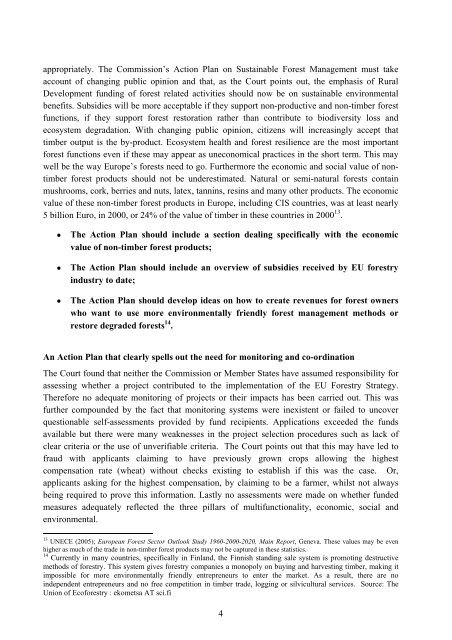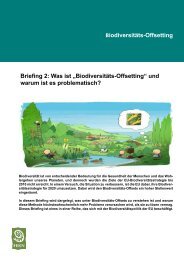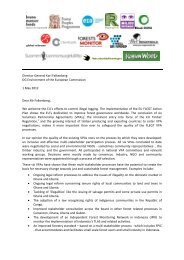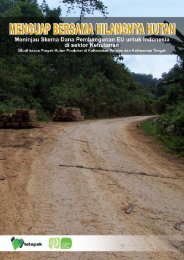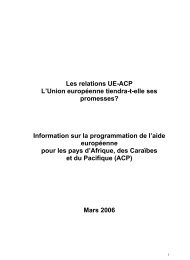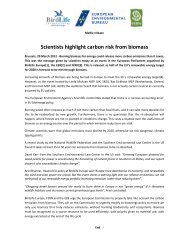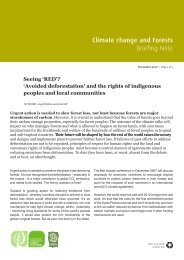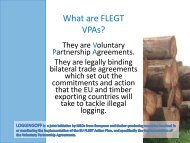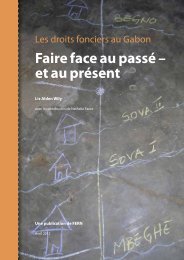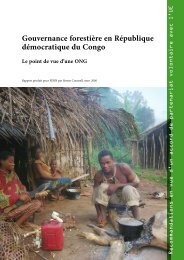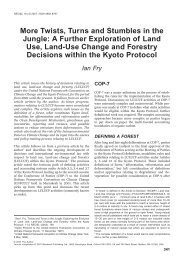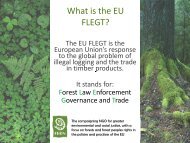Towards an Action Plan for Sustainable Forest Management
Towards an Action Plan for Sustainable Forest Management
Towards an Action Plan for Sustainable Forest Management
You also want an ePaper? Increase the reach of your titles
YUMPU automatically turns print PDFs into web optimized ePapers that Google loves.
appropriately. The Commission’s <strong>Action</strong> Pl<strong>an</strong> on <strong>Sustainable</strong> <strong>Forest</strong> M<strong>an</strong>agement must take<br />
account of ch<strong>an</strong>ging public opinion <strong>an</strong>d that, as the Court points out, the emphasis of Rural<br />
Development funding of <strong>for</strong>est related activities should now be on sustainable environmental<br />
benefits. Subsidies will be more acceptable if they support non-productive <strong>an</strong>d non-timber <strong>for</strong>est<br />
functions, if they support <strong>for</strong>est restoration rather th<strong>an</strong> contribute to biodiversity loss <strong>an</strong>d<br />
ecosystem degradation. With ch<strong>an</strong>ging public opinion, citizens will increasingly accept that<br />
timber output is the by-product. Ecosystem health <strong>an</strong>d <strong>for</strong>est resilience are the most import<strong>an</strong>t<br />
<strong>for</strong>est functions even if these may appear as uneconomical practices in the short term. This may<br />
well be the way Europe’s <strong>for</strong>ests need to go. Furthermore the economic <strong>an</strong>d social value of nontimber<br />
<strong>for</strong>est products should not be underestimated. Natural or semi-natural <strong>for</strong>ests contain<br />
mushrooms, cork, berries <strong>an</strong>d nuts, latex, t<strong>an</strong>nins, resins <strong>an</strong>d m<strong>an</strong>y other products. The economic<br />
value of these non-timber <strong>for</strong>est products in Europe, including CIS countries, was at least nearly<br />
5 billion Euro, in 2000, or 24% of the value of timber in these countries in 2000 13 .<br />
• The <strong>Action</strong> Pl<strong>an</strong> should include a section dealing specifically with the economic<br />
value of non-timber <strong>for</strong>est products;<br />
• The <strong>Action</strong> Pl<strong>an</strong> should include <strong>an</strong> overview of subsidies received by EU <strong>for</strong>estry<br />
industry to date;<br />
• The <strong>Action</strong> Pl<strong>an</strong> should develop ideas on how to create revenues <strong>for</strong> <strong>for</strong>est owners<br />
who w<strong>an</strong>t to use more environmentally friendly <strong>for</strong>est m<strong>an</strong>agement methods or<br />
restore degraded <strong>for</strong>ests 14 .<br />
An <strong>Action</strong> Pl<strong>an</strong> that clearly spells out the need <strong>for</strong> monitoring <strong>an</strong>d co-ordination<br />
The Court found that neither the Commission or Member States have assumed responsibility <strong>for</strong><br />
assessing whether a project contributed to the implementation of the EU <strong>Forest</strong>ry Strategy.<br />
There<strong>for</strong>e no adequate monitoring of projects or their impacts has been carried out. This was<br />
further compounded by the fact that monitoring systems were inexistent or failed to uncover<br />
questionable self-assessments provided by fund recipients. Applications exceeded the funds<br />
available but there were m<strong>an</strong>y weaknesses in the project selection procedures such as lack of<br />
clear criteria or the use of unverifiable criteria. The Court points out that this may have led to<br />
fraud with applic<strong>an</strong>ts claiming to have previously grown crops allowing the highest<br />
compensation rate (wheat) without checks existing to establish if this was the case. Or,<br />
applic<strong>an</strong>ts asking <strong>for</strong> the highest compensation, by claiming to be a farmer, whilst not always<br />
being required to prove this in<strong>for</strong>mation. Lastly no assessments were made on whether funded<br />
measures adequately reflected the three pillars of multifunctionality, economic, social <strong>an</strong>d<br />
environmental.<br />
13 UNECE (2005); Europe<strong>an</strong> <strong>Forest</strong> Sector Outlook Study 1960-2000-2020, Main Report, Geneva. These values may be even<br />
higher as much of the trade in non-timber <strong>for</strong>est products may not be captured in these statistics.<br />
14 Currently in m<strong>an</strong>y countries, specifically in Finl<strong>an</strong>d, the Finnish st<strong>an</strong>ding sale system is promoting destructive<br />
methods of <strong>for</strong>estry. This system gives <strong>for</strong>estry comp<strong>an</strong>ies a monopoly on buying <strong>an</strong>d harvesting timber, making it<br />
impossible <strong>for</strong> more environmentally friendly entrepreneurs to enter the market. As a result, there are no<br />
independent entrepreneurs <strong>an</strong>d no free competition in timber trade, logging or silvicultural services. Source: The<br />
Union of Eco<strong>for</strong>estry : ekometsa AT sci.fi<br />
4


